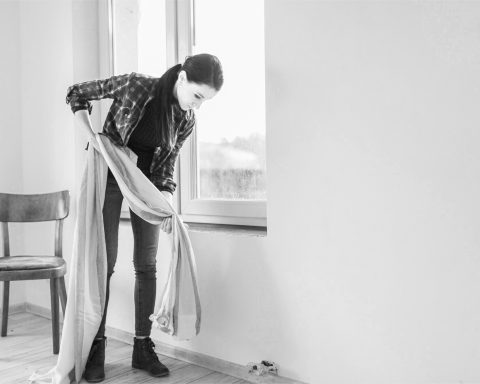Picture this: you walk into your home after a hard day, kick off your shoes, and take a big breath, only to find the air feels… blah. Maybe it’s stuffy, maybe it smells like last night’s food, or maybe you just can’t quite put your finger on it. That’s because indoor air — yes, the air you breathe every day — can be contaminated with sneaky substances such as dust, pet dander, and invisible contaminants you didn’t invite in.
The reality is, you’re not alone. Many houses contain stagnant air, which can have an unnoticed impact on your overall well-being. But don’t worry, this isn’t one of those depressing lectures. This is your straightforward, helpful guide to maximizing indoor air quality and bringing fresh, feel-good vibes back into your space.
You’ll explore simple strategies to increase air circulation, eliminate airborne debris, and enhance indoor air quality without breaking the bank or undergoing a complete overhaul of your house. Consider it a deep breath for your home; in exchange, you’ll get cleaner lungs, better sleep, and a home that just feels better.
So take a cup of tea, sit comfortably, and learn how to breathe cleaner, fresher air every day. You clear the air, one wise step at a time.
Why indoor air quality matters
Be honest: When was the last time you considered the air quality in your home?
You clean surfaces and tidy up, but indoor air is frequently forgotten. However, it is critical for your health. According to the EPA, indoor air may be two to five times more contaminated than outside air, with typical contaminants such as VOCs, mold spores, and pet dander causing headaches, tiredness, and respiratory problems.
The World Health Organization estimates that indoor air pollution claims the lives of approximately 4.3 million people worldwide each year. That’s because poor air quality can cause allergies, irritate the lungs, and diminish comfort. That is why it is crucial to follow recommended practices for air circulation.
But don’t worry: there’s no need for expensive solutions. In the sections below, you’ll learn methods like opening windows, utilizing air purifiers, and replacing filters that enhance airflow and minimize allergies.
Though invisible, the air you breathe can be controlled, making your house seem fresher, cleaner, and healthier on a daily basis.
Health risks of poor air circulation
You’re in a stifling area with limited ventilation; what’s in the air? Poor circulation traps allergens, mold spores, and volatile organic compounds (VOCs), which can lead to asthma, allergies, and headaches.
Stagnant air harms your health by allowing dust, pet dander, and pollutants to accumulate. This might not matter as much to most, but it can make breathing difficult for vulnerable people.
Poor air circulation can provide the following health risks:
- Higher risk of sickness because bacteria persist in stale air
- Dust mites, mold, and pet dander can cause allergies to flare up
- Increased respiratory problems, such as asthma and shortness of breath
- Prolonged exposure to irritants can cause headaches, fatigue, and dizziness
Who is most at risk?
- Individuals with asthma or allergies
- Children and the elderly have delicate lungs
- People with compromised immune systems
Good ventilation is not only comfortable, but it is also essential for maintaining good health. Even little changes in ventilation may have a significant impact on everyone in your home.
Read more: Common Misconceptions About Indoor Air Pollution
Indoor air vs. outdoor air: The hidden danger
Did you know your house could be more polluted than the street outside? It may sound unexpected, but it is true! Indoor air can be 2 to 5 times more contaminated than outside air due to inadequate ventilation and the presence of synthetic materials in many modern homes.
Paint, carpets, and cleaning products can all emit dangerous chemicals that remain in the air, especially if there is insufficient air circulation to carry them out. What’s the problem?
Most individuals do not notice. Indoor air quality is frequently overlooked because it is invisible, and symptoms, such as fatigue, headaches, or irritation, are often easy to dismiss or attribute to other causes.
However, the “out of sight, out of mind” attitude might be harmful. Poor air quality worsens gradually, becoming a subtle contributor to long-term respiratory and health problems.
Recognizing it as a hidden risk is the first step toward establishing a safer living situation.
Long-term benefits of clean air
Clean indoor air has long-term benefits: increased oxygen flow improves brain function and cardiovascular health, while reduced exposure to contaminants such as dust, mold, and VOCs helps avoid respiratory problems.
According to research data, better air quality is associated with greater cognitive function and fewer feelings of anxiety and sadness.
Air quality also influences how well you sleep. It has been observed that increased levels of indoor PM2.5 and CO₂ can reduce sleep length and quality.
Maintaining clean indoor air leads to fewer respiratory ailments, improved attention, and better sleep, ultimately making your home healthier and more pleasant in the long term.
Best practices for improving indoor air quality
Improving air quality at home is a long-term investment that results in greater health, clearer thinking, and deeper sleep. A 2021 research study published in Sustainable Cities and Societies discovered that improved ventilation and air purification technologies lowered indoor PM2.5 concentrations in residential areas by up to 61.85%.
In fact, researchers connected improved indoor air quality to a 61% rise in cognitive function scores in working households, underscoring the notion that fresh air nourishes not just our lungs but also our minds.
Thus, in the next section, you’ll learn the most effective strategies, backed by science, to reduce allergies, eliminate pollutants, or simply keep your living area breathable and balanced.
Maximize natural ventilation
Take a deep cleansing breath. This is how your body feels when fresh air enters your home. Opening the windows and doors allows natural air to flow, which improves the atmosphere in your house.
Research indicates that opening 20% of a room’s windows reduces CO₂ levels between 13 to 86 minutes, depending on occupancy. Research published in Frontiers in Environmental Health discovered that homes lacking cross ventilation are more than three times more likely to report poor air quality.
Natural ventilation enhances airflow, resulting in a healthier and more pleasant living environment.
Here are some easy steps that you can follow for natural ventilation:
- Choose your time of day. If noise or pollution is a problem, ventilate briefly during calmer, cleaner periods of the day.
- Open the windows. Apartment occupants can open windows or balcony doors during low-traffic hours, but it is recommended to use mesh screens for added safety.
- Create a cross-breeze. Open windows on opposing sides of your home to produce a cross-breeze that eliminates stale air while bringing in fresh air.
- Add a fan. Use one fan near a window to bring in fresh air, and another near a separate window to exhaust the inside air.
- Add mechanical fans. In rooms with limited window access, use air-circulating fans or window vent inserts to ensure that air flows safely and efficiently.
Use mechanical ventilation systems wisely
Consider your home’s mechanical ventilation systems, which include kitchen and bathroom exhaust fans, ceiling fans, and HVAC units, to be the lungs of the living space. When utilized properly, they help maintain adequate air circulation by replacing stale air with fresh, clean air.
Studies have shown that mechanical ventilation systems can significantly reduce indoor concentrations of fine particulate matter (PM2.5), which is hazardous to respiratory health.
According to the National Institute of Standards and Technology (NIST), well-maintained HVAC systems may efficiently manage indoor pollution levels, resulting in improved air quality and overall comfort.
Here are some tips to maximize your mechanical ventilation systems and enhance indoor air quality:
- Know when to run exhaust fans. Run kitchen exhaust fans while cooking and for 15 minutes thereafter to eliminate aromas, moisture, and oil from the air.
- Keep bathroom fans running. To minimize humidity and avoid mildew, use bathroom fans both during and after showers.
- Regularly maintain your systems. To keep the system running smoothly, clean or replace HVAC filters every 1-3 months, depending on the levels of pet dander, pollen, and dust.
- Run your fans efficiently. To improve airflow and reduce HVAC demand, turn ceiling fans counterclockwise in summer and clockwise in winter.
- Check regularly. Check the fresh air intakes regularly to ensure they are clear and functioning properly for ventilation.
Read more: Role of Home Ventilation Systems in Improving Air Quality
Incorporate natural air purifiers
Consider your home a green sanctuary, where certain houseplants organically enhance indoor air quality. The Peace Lily (Spathiphyllum ‘Mauna Loa’) can eliminate benzene (1,725 µg/h), formaldehyde (674 µg/h), and trichloroethylene (1,128 µg/h).
The Snake Plant (Sansevieria trifasciata ‘Laurentii’) eliminates 1,196 µg/h of benzene, 1,304 µg/h of formaldehyde, and 405 µg/h of trichloroethylene. The Spider Plant (Chlorophytum comosum) removes 560 µg/h of formaldehyde.
Adding these plants to other air quality initiatives, such as using air purifiers and ensuring proper ventilation, promotes better indoor air quality. Plants cannot replace air quality monitoring or duct cleaning, but they can provide a natural element to your entire air care regimen.
Clean and maintain ventilation systems
Like previously said, your home’s ventilation system functions like its respiratory system; when it is clean and well-maintained, everything breathes more easily. Neglecting home air duct cleaning and HVAC filter maintenance can lead to the accumulation of dust, allergens, and other pollutants, thereby lowering indoor air quality.
The US Department of Energy revealed that 25-40% of the energy required to heat or cool a home is wasted, and pollutants in the heating and cooling system make it work harder.
According to some estimates, clean ducts enable the system to operate more efficiently, potentially reducing your energy costs by up to 20%.
Here are simple steps for keeping your ventilation system clean and your interior air fresh:
- Replace HVAC filters every 1-3 months, depending on usage, pets, and allergies.
- Clean vents and registers on a monthly basis.
- Schedule duct cleaning every 3-5 years, or more frequently if you have pets, are renovating, or are concerned about mold.
- Exhaust fans should be cleaned quarterly using a vacuum or a moist cloth.
- To ensure proper airflow, clear clutter from near outdoor HVAC systems.
- Use an air quality meter to monitor and evaluate your system’s efficacy.
- Install air purifiers in high-traffic or allergy-prone areas as required.
Use household air purifiers effectively
Your home air purifier is a silent sentinel, working to improve indoor air quality. To achieve the greatest results, select the appropriate unit, position it strategically, and maintain it on a regular basis.
According to studies, HEPA filters installed near busy highways considerably reduce hazardous black carbon and ultrafine particles indoors. For optimal results, place your purifier in high-traffic or allergy-prone areas, preferably in a central location that is away from walls to ensure sufficient ventilation.
Regular maintenance is required; follow the manufacturer’s instructions to replace filters and maintain your purifier effectively.
Using an air purifier in conjunction with other measures, such as duct cleaning and proper ventilation, promotes a healthier and more pleasant home environment.
In conclusion
Your house should feel like a breath of fresh air, not a stifling cave full of hidden toxins.
When indoor air quality deteriorates, the symptoms are not usually visible. You might have difficulty sleeping, frequent headaches, or a persistent cough that you cannot explain. That’s why monitoring your home’s air quality isn’t just beneficial; it’s necessary.
This tutorial guided you through practical, achievable techniques to regain control, including using household air purifiers and practicing proper air circulation habits. Whether it’s committing to regular home air duct cleaning or simply becoming aware of air circulation best practices, the power is in your hands (and vents).
Don’t wait for your lungs to raise the alarm. Start small, be consistent, and follow best practices to guarantee daily air quality that benefits your body and emotions. Because caring for the air you breathe is, in essence, caring for yourself.
If you want to see more resources on air circulation, check out the Household Management Science Labs. The lab uses the research of the Institute for Life Management Science to produce courses, certifications, podcasts, videos, and other tools. Visit the Household Management Science Labs today.
Photo by Freepik





